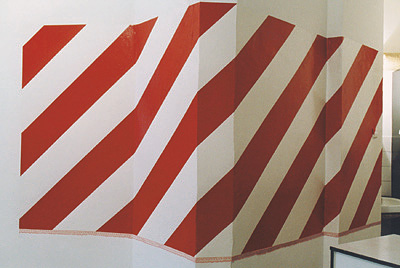| Revista Umělec 2001/5-6 >> The Warsaw Bomb | Lista de todas las ediciones | ||||||||||||
|
|||||||||||||
The Warsaw BombRevista Umělec 2001/5-601.05.2001 Władysław Kazmierczak | gallery | en cs |
|||||||||||||
|
Gallery Raster, based in Warsaw, Poland, continues our series of articles on new artist-run exhibition spaces in central and eastern Europe.
Gallery Raster is an artistic and sociological phenomenon in Poland. But the history of the gallery goes back to 1995 when Łukasz Gorczyca, Michał Kaczyński and Adam Olszewski launched the art magazine Raster, an irregular publication open to new trends in art. In the end this cost them dearly because, for some time after, nobody took them seriously. At least not until 1998. That year Raster commissioned the article “The Integrated Circle of Polish Art” from Piotr Śmigłowicz and came up with the “Raster Dictionary,” both of which attracted attention to these young people who were most insolently usurping the right to judge Polish artistic life. Their revolutionary ideas delved into the sphere of language by tagging a particular phenomenon, person or institution with an offensive name. Their mischievous commentaries poked fun especially at the two biggest galleries in Warsaw: Center for Contemporary Art at Ujazdowski Castle and Zachęta Gallery. But that’s not all. Raster explained to us in most unsubtle terms that the entire art system was sick. It pointed fingers at situations both sorry and sublime. And what they said roughly equaled unofficial opinions in Poland. Raster’s “power of irony” became truly powerful when the magazine went on-line. The now famous categorization of galleries and Polish art critics, separated into hawks and penguins, caused wonderful scandal. As a result, Raster once again came out in printed form when those with access to the Internet printed it out for friends who were not so lucky. Raster proved to be intelligent, expansionistic and opinionated. Raster — like all masters of rebellion — asked itself a question: How many times can one poke fun at someone and bring that person down a little? Not so many, it turns out. Starting a gallery seemed to be the next logical step in the realization of “a vision of disagreement” with found reality. The gallery became the necessary glue for its founders to stay together, promote their own ideas and show the flogged art giants that there was another way to do things. But everybody wondered: How long could an unprofitable commercial gallery last? How long could Raster finance such brand of entertainment from their own pockets? The gallery could potentially earn fifty percent of all sold art works, but only if it sold something. In any case, young people boundlessly adore Raster. They adore the gallery for defending and supporting their right to exist, for exposing falseness and boredom, and for preferring common things, humor and absolute freedom, for being a bit anarchist, and independent of the establishment. From an artistic and critical point of view, the visionaries behind Gallery Raster accept Polish pop, a critical stance and a kind of sharp reaction to the world. But they also enjoy some transavant-garde ideas, conceptualism and action art. They even appreciate painting! Which is mightily looked down upon in certain circles. They fearlessly write about themselves on the Internet: “A Grand Gallery Opening — 24 April 2001. On a dark and pretty damp evening, a crowd several hundred strong tramped through the gallery for two hours. During the formal opening, Mały Szu (unplugged for the first time) put on a live show. Mariusz Maciejewski installed live sculptures on the garbage can in the courtyard, while inside the gallery Tom Dale’s installation of light and sound happily twinkled. Two murals by Monika Sosnowska and magazine/wallpaper made from the magazine Raster covered the walls. Technical difficulties prevented the showing of a film by Wilhelm Sasnal (the projector needed a special set of cables). After the opening, guests were invited to the club Pod Gwiazdami (Under the Stars), where this historic evening rolled on into endless conversation.” Here’s just a few of the exciting artists from the young generation Gallery Raster gave to the world in 2001: Wilhelm Sasnal, Marcin Maciejowski, Rafał Bujnowski, Maciej Sawicki, Małgorzata Jablońska, Justyna and Wojtek Kucharczyk, and the duo, Magisters (Sławek Elsner and Monika Sosnowska). All artists exhibiting at Raster have proved to be skilled observers of today’s absurd world. This year Gallery Raster has all new events in store for its public. In April, Go Biking will take the audience for a group bicycle ride, the aim being to inspire people to live a more healthy lifestyle. A more traditional event, however, is Rafał Bujnowski’s exhibition of 150 paintings (his entire artistic production). In March, the gallery will commence its international program with an exhibition of Siggi Hofer, a young artist from Vienna. And in May, there will be a seminar on what to do with prefab residential housing and how to live in it. The seminar is actually a pretext for an exhibition of the French artist Yves Belogey, who likes to visit housing complexes around the world and enjoys painting monumental “portraits” of what he sees there. Autumn brings with it an exhibition of Polish cult hero-artist Zbigniew Libera, whom Lego once sponsored to build small concentration camps out of their plastic toy blocks. In addition to exhibitions, the gallery will also organize concerts and talks on cooking (simple, cheap and healthy) and will begin the regular “Friday Party” which will feature a film, concert, opening or event, and will basically be chance to get together. Thanks to a lucky string of events, the young faces behind Gallery Raster have gradually come to achieve their main objective: to change the image of Polish art. Translated by Małgosia Kazmierczak
01.05.2001
Artículos recomendados
|
|||||||||||||









Comentarios
Actualmente no hay comentariosAgregar nuevo comentario